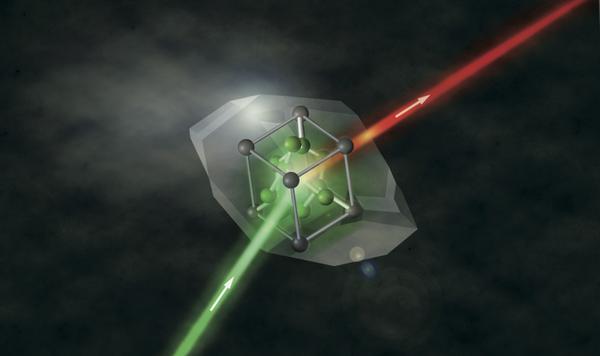Aug 26 2013
Researchers have for the first time created an X-ray laser based on a solid. The method developed at DESY's free-electron laser FLASH opens up new avenues of investigation in materials research, as reported by the team of Prof. Alexander Föhlisch of the Helmholtz Zentrum Berlin (HZB) in the British scientific journal "Nature."
"This technology makes it possible to analyse sensitive samples that otherwise are quickly destroyed by intense X-ray light," notes co-author Prof. Wilfried Wurth of the University of Hamburg and the Hamburg Center for Free-Electron Laser Science (CFEL), a collaborative effort by DESY, the Max Planck Society and the University of Hamburg.
 The incoming laser light (depicted in green) excites the atoms in the silicon crystal to produce its own laser pulse with a slightly longer wavelength (depicted in red). (Credit: HZB/E. Strickert)
The incoming laser light (depicted in green) excites the atoms in the silicon crystal to produce its own laser pulse with a slightly longer wavelength (depicted in red). (Credit: HZB/E. Strickert)
Unlike laser diodes in home DVD players, it has thus far not been possible to build X-ray lasers as compact devices based on a solid. For one thing, the energy needed to excite the laser medium is too high. In addition, the excitation must be of such a high intensity that it cannot be implemented in a compact device. For this reason, X-ray lasers are normally large pieces of equipment that are fed by a particle accelerator. The high-energy electrons from the accelerator, at nearly the speed of light, are sent by powerful magnets down a tightly packed slalom course, emitting X-ray flashes at every curve which add up to a laser-like light pulse. This is known as the "Free-Electron Laser" (FEL) principle.
The researchers used DESY’s free-electron laser FLASH to excite a silicon crystal to emit X-ray radiation. The high energy of the FLASH pulses is enough to knock a relatively tightly bound electron out of the electron shell of each of the silicon atoms, with the atoms thereby becoming ionized. Shortly thereafter, this hole is filled by a less strongly bound electron, which changes to a lower-energy state. The energy released by this step is, in principle, large enough to generate a small X-ray flash. Only infrequently, though, does it get emitted as (X-ray) light; for the most part it is passed on to another electron which, because of this impact, gets catapulted out of the atomic shell. At such high energies, this "Auger process" is a lot more frequent than the emission of a radiation flash, making it virtually impossible to implement a conventional laser in the X-ray area. If intense X-ray pulses are used in materials investigation, the produced electrons greatly heat up the sample, quickly destroying it.
The scientists found a way to suppress the here-unwanted Auger process. They did so by taking advantage of the laser principle of stimulated emission: In a laser medium, one photon triggers emission of the next, the two of them then stimulate the emission of one photon each, and so on, which then snowballs into a laser flash. This process starts by a spontaneously emitted photon. While it is true that, with the high energies in the X-ray area, spontaneous emission of a photon is far less frequent than the Auger process, the scientists used FLASH’s intense light to ionize so many atoms all at one time that the rare spontaneously emitted photons still encountered enough other ionized atoms to stimulate the emission of further photons. Thus, a photon snowball rolls through the silicon crystal and gains the upper hand on the Auger process. In a similar fashion, another group of researchers had already excited neon gas to emit X-ray radiation, and in so doing implemented the first X-ray laser on an atomic basis.
With this trick, the silicon emits an X-ray laser pulse of its own. First, however, it must be excited to do so by another intense X-ray laser like FLASH and, furthermore, the resulting X-ray light has somewhat less energy than the incoming pulse. Even though, the method offers a decisive advantage: The X-ray light generated can itself be used to study the generating material, and the sample does not get heated up as much and is therefore not destroyed. "As with lasers, the photons all work together and amplify each other," comments first author Dr. Martin Beye. "We obtain a very high measurement signal in this way."
The researchers were hereby enabled to make detailed measurements of the structure of the valence band of the semiconductor material silicon. This served most of all to prove that the new method delivers correct results, since the valence band of silicon has already been very well characterized. "But the process works exactly the same way with other materials too," Wurth emphasizes. "At the same time, the time evolution of certain processes can also be followed." This, he thinks, makes it possible, for example, to observe how an insulator becomes a conductor through optical switching by another laser. Using the new method, X-ray sources could also become attractive for areas of research that have heretofore only been able to work with neutron scattering.
Deutsches Elektronen-Synchrotron DESY is the leading German accelerator center and one of the leading in the world. The research center is financed 90 percent by the German Federal Ministry of Education and Research (BMBF) and 10 percent by the German federal states of Hamburg and Brandenburg. At its Hamburg and Zeuthen (near Berlin) locations, DESY develops, builds and operates large particle accelerators, using them to research the structure of matter. DESY’s combination of photon research and particle physics is unique in Europe.